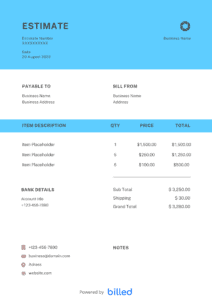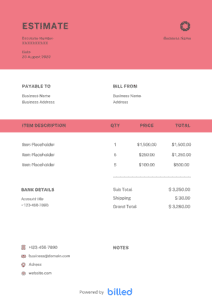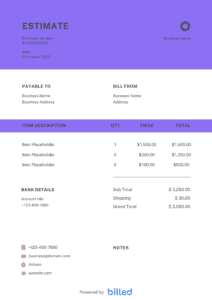Remodeling Estimate Template
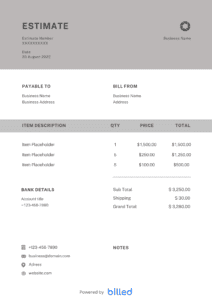
Download the free customizable and printable remodeling estimate template from Billed and quickly create a professional estimate for your next job.
Get Your Free Remodeling Estimate Template
Have you recently started your business? A complete and accurate estimate is the first written customer contact. Download the free remodeling estimate template from Billed to satisfy potential customers of your services and products.
With our beautiful and editable remodelling estimate template, you can quickly create and send detailed and accurate estimates in a legally secure manner.
Our attractive and time-saving remodeling estimate templates are available in various popular formats like Google Sheets, Google Docs, PDF, Word, and Excel. You can download it for free.
Download Free Remodeling Estimate Template
Estimate With Billed
Print, download or send your estimate for free with Billed
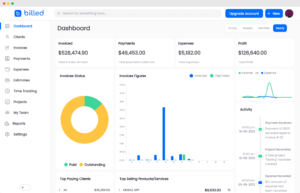
Estimate With Billed
Download the free professionally designed, fully customizable estimate template from Billed

Bathroom Remodeling Estimate Template
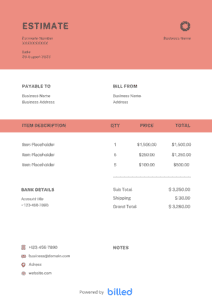
Are you looking for a ready-to-use bathroom remodeling estimate template? Then download this elegant and fully-editable estimate template for free. It helps you create and send detailed and high-quality estimates quickly and easily.
Download For:
Estimate With Billed
Create a unique estimate in seconds with Billed and stand out from your competitors.

Residential Remodeling Estimate Template
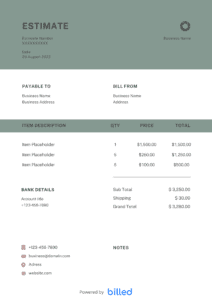
Use this multifunctional residential remodeling estimate template to appear experienced and professionally in front of your customers right from the beginning. Try it and save your valuable time and money designing a new estimate every time.
Download For:
Cost Estimate Remodeling Property Template
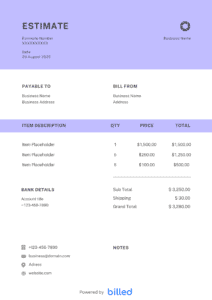
You no longer have to create your offers manually. Download this cost estimate remodeling property template and start creating professional-looking and detailed estimates with just a few clicks. Try it and get inspiration from it to make your next estimates.
Download For:
- What is a Remodeling Estimate?
- Factors Affecting Remodeling Estimates
- Why Use Our Estimate Templates?
- What should be included in the Remodeling Estimate?
- Tips While Making a Remodeling Estimate
- How to Make a Remodeling Estimate?
- Some Other Templates
- Download The Remodeling Estimate Template For Free
What is a Remodeling Estimate?
Remodeling estimates are valuable tools for homeowners, contractors, and project managers. They offer insights into the financial aspects of a remodeling project, helping individuals make informed decisions and plan their budgets accordingly. A remodeling estimate considers various factors, such as the project’s scope, materials and labor costs, structural changes, and design preferences.
Factors Affecting Remodeling Estimates
Several factors influence the accuracy and complexity of a remodeling estimate. Understanding these factors is essential to ensure a realistic assessment of the project’s financial requirements.
Scope of the Project
The scale and complexity of the remodeling project significantly impact the estimate. Whether undertaking a minor renovation or a full-scale remodel, the scope determines the extent of work, materials, and labor involved.
Materials and Labor Costs
The choice of materials and the cost of skilled labor play a vital role in the estimate. High-quality materials and specialized labor can increase overall expenses, while more affordable options can help manage costs.
Structural Changes
If your remodeling project involves structural modifications, such as removing or adding walls, it adds complexity to the estimate. Structural changes require careful consideration of engineering requirements and potential additional costs.
Design and Customization
The level of design detail and customization desired also affect the estimate. Intricate designs, unique finishes, and custom-built elements often come at a higher cost.
Why Use Our Estimate Templates?
Whether you’re a homeowner planning a renovation or a contractor working on multiple remodeling projects, utilizing remodeling estimate templates can bring numerous benefits. Here are some compelling reasons for using our remodeling estimate templates:
Time-Saving:
Our templates are pre-designed and organized, saving valuable time creating estimates from scratch. You can fill in the required information and customize the template to suit your project requirements.
Consistency:
Using our easy-to-use templates ensures consistency in your estimates. By following a standardized format, you can present a professional image to your clients and stakeholders. Consistent estimates also make it easier to compare and evaluate different projects.
Accuracy:
Our remodeling estimate templates are designed to include all the essential cost elements, ensuring you don’t overlook expenses. The structured format allows you to break down the project into specific tasks, making it easier to estimate costs accurately.
Detailed Cost Analysis:
Our templates provide a detailed analysis of costs, including materials, labor, subcontractors, permits, and any other relevant expenses. This holistic approach ensures that you understand the total investment required for the remodeling project.
Customizable
While our templates provide a structured framework, they are flexible enough to accommodate customization. You can easily modify the template to reflect your unique project requirements, such as specific material costs or labor rates.
Professional Presentation:
Our remodeling estimate templates are designed with a professional layout and formatting, enhancing the overall presentation of your estimates. Clear headings, subheadings, and itemized cost breakdowns make it easier for clients to understand the estimate and make informed decisions.
Cost Monitoring and Control:
Using our templates, you can easily track and monitor the actual project costs against the estimated amounts. This helps you identify deviations and take necessary actions to control costs and avoid budget overruns.
Professionalism and Credibility:
Presenting well-structured and detailed remodeling estimates demonstrates professionalism and credibility to your clients. It instills confidence in your expertise and reliability, potentially increasing client satisfaction and repeat business.
Adaptability:
Our templates can be used for various types of remodeling projects, whether residential or commercial. They can be customized to accommodate different industries, project sizes, and specific requirements.
What should be included in the Remodeling Estimate?
When creating a remodeling estimate, it’s important to include several key elements to ensure accuracy and clarity. Here are the essential components that should be included in a remodeling estimate:
Client Information:
Begin the estimate by having the client’s name, address, contact details, and any other relevant information.
Project Description:
Provide a detailed description of the project, including the type of remodeling work to be done, such as kitchen renovation, bathroom remodeling, or basement finishing.
Scope of Work:
Outline the specific tasks and activities involved in the remodeling project. This could include demolition, construction, electrical work, plumbing, painting, and other relevant tasks.
Materials and Supplies:
List all the materials and supplies required for the project, including quantities and unit costs. This may include flooring, tiles, fixtures, cabinets, paint, hardware, and any other necessary materials.
Labor Costs:
Estimate the labor costs associated with the project. This includes the hours or days required for each task and the corresponding labor rates. Break down the labor costs by trade or job category, such as carpentry, electrical, plumbing, etc.
Subcontractor Costs:
If subcontractors are involved in the project, estimate their costs. This may include subcontractors for specialized tasks like electrical or HVAC work. Include their contact information and a breakdown of their charges.
Permits and Inspections:
Determine the cost of permits and inspections required for the remodeling project. Research the specific permits needed for the work and include the associated fees.
Equipment and Tools:
If any specialized equipment or tools are required for the project, include the costs associated with renting or purchasing them. This could include scaffolding, power tools, or heavy machinery.
Contingencies:
Account for unforeseen expenses or changes that may arise during the project. Including a contingency amount as a percentage of the overall project cost is advisable to accommodate unexpected situations.
Taxes and Fees:
Consider any applicable taxes or fees that may be required, such as sales tax or disposal fees for construction waste. Include these costs in the estimate.
Payment Terms:
Clearly state the payment terms and schedule, including any deposits or progress payments required, the due dates for each payment, and any penalties for late payments.
Expiration Date:
Indicate an expiration date for the estimate to ensure the client sure understands the validity of the provided costs. This allows for adjustments if the estimate is not accepted within a specified timeframe.
Terms and Conditions:
Include any terms, conditions, or disclaimers that apply to the estimate. This may include information regarding change orders, project delays, warranty, or cancellation policies.
Total Estimate:
Summarize all the costs, including materials, labor, subcontractors, permits, and any other expenses, to provide a clear total estimate for the remodeling project.
Tips While Making a Remodeling Estimate
Accuracy is essential when creating a remodeling estimate to ensure that the project fits within the budget and meets the client’s expectations. Here are some tips to help you make a comprehensive and reliable remodeling estimate:
Understand the Scope: Begin by thoroughly understanding the scope of the remodeling project. Discuss the details with the client and visit the site if necessary to get a clear picture of the work required.
Take Detailed Measurements: Precise measurements are essential for accurate cost calculations. Use a measuring tape and create a detailed sketch or digital plan for remodelling the area.
Break Down the Project: Divide the project into smaller components such as labor, materials, permits, and additional costs. Breaking down the estimate makes it easier to track expenses and helps the client understand the cost distribution.
Research Material Costs: Research the current prices of construction materials from multiple suppliers. Prices can fluctuate, so it’s essential to have up-to-date information.
Account for Labor Costs: Factor in the labor costs based on the complexity of the work, the number of workers required, and the estimated time needed to complete each task.
Consider Hidden or Unforeseen Costs: Remodeling projects often encounter unexpected structural problems, electrical issues, or water damage. Include a contingency amount (usually 10-20% of the total estimate) to cover unforeseen expenses.
Include Permit Costs: If permits are required for the remodeling project, ensure the estimate includes the associated fees.
Calculate Overhead and Profit Margin: Account for your business’s overhead costs (office rent, insurance, utilities, etc.) and add a reasonable profit margin to the estimate.
Provide Multiple Options: Different options for materials and finishes at various prices. This gives the client flexibility in making choices that fit their budget.
Present a Clear and Detailed Estimate: Organize the estimate in a clear and itemized format so the client can easily understand the costs associated with each aspect of the project.
Be Transparent: Ensure the client knows what is and isn’t included in the estimate. Clearly outline any exclusions to avoid misunderstandings later on.
Review and Double-Check: Review the estimate thoroughly to ensure accuracy before presenting it to the client. Check for any potential errors or omissions that might affect the final cost.
Keep Communication Open: Ensure that you are readily available to answer any queries or worries that the client may have regarding the estimate. Open communication fosters trust and confidence in your services.
Be Realistic with Timelines: Provide a realistic timeline for completing the project. Rushing the job may lead to mistakes, while more extended timelines may be necessary for the client.
Update the Estimate as Needed: If the scope of the project changes or unforeseen issues arise during construction, update the estimate accordingly and communicate the changes to the client.
By following these tips, you can create a remodeling estimate that accurately reflects the project’s cost, setting the foundation for a successful and satisfactory renovation experience.
How to Make a Remodeling Estimate?
A remodeling estimate is a crucial document used to determine whether to proceed with a project. It helps you evaluate the various aspects of the job and make informed decisions. Let’s break down the key elements of a remodeling estimate:
Download the Free Remodeling Estimate Template from Billed: To get started, access the free template provided by Billed. This template will serve as a foundation for creating your remodeling estimate.
Include Company Details: Add your company’s information at the top of the estimate. Include your company name, address, contact details, and other relevant information identifying your business.
Add Customer’s Details: Include the customer’s details below your company information. This should include the client’s name, address, and contact information. Having the customer’s details ensures that the estimate is personalized and easily identifiable for them.
Title and Date: Give the estimate a clear title, such as “Remodeling Estimate”, and include the issue date. This helps you and the customer keep track of when the estimate was created.
Contents and Quantity:
- List all the products and services targeted for the estimate.
- Be specific and clearly describe each item or service required for the remodeling project.
- Include the quantity needed for each item.
Unit Price and Total Amount: Assign a unit price to each item or service and calculate the total amount by multiplying the unit price by the quantity. This gives the customer an understanding of the cost breakdown.
Delivery Date: Specify the expected delivery date for the products and services mentioned in the estimate. This helps the customer plan for the project timeline.
Estimate Expiration Date: Include an expiration date for the estimate. This indicates the timeframe the customer can accept the estimate and ensures they know the validity period.
Save and Send: Once you have provided all the required information and verified the estimate’s accuracy, save it in a shareable format, like PDF.Then, send the estimate to the customer via email or other preferred communication channels.
You can create a professional and comprehensive remodelling estimate by following these steps and utilizing the Billed template. Including the company and customer details ensures personalization and easy identification, while the clear breakdown of costs helps the customer make an informed decision. Don’t forget to save and send the estimate promptly to move forward with the remodeling project smoothly.
Download The Remodeling Estimate Template For Free
Billed Right’s free remodeling estimate template allows you to easily create and customize a comprehensive remodeling estimate for any project. Get started today to save time and money!


